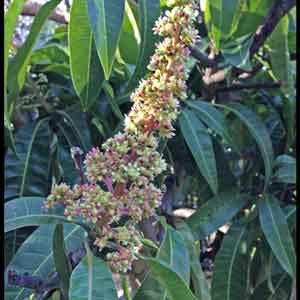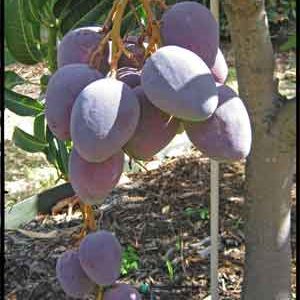Mangifera indica
Mango
Origin
Thought to be native to north east India, northern Myanmar and possibly Nepal in the lower parts of the Himilayas. The genus contains about 70 species and there is considerable diversity within M. indica. It has been cultivated by mankind for over 4000 years.
Climate
It is a tropical sub-tropical species tolerant of hot dry summer weather. Ideal temperatures are 24-30°C with vegetative growth ceasing below 15°C. They have only moderate tolerance of frosts. High temperatures during pollen formation, 33-36°C, reduce pollen viability.
Plant Description
Wild trees in their native environment can grow to over 40m tall, but in cultivation they are usually not more than 12m unpruned and half this again with more intensive management. The species is evergreen with a long taproot and spirally arranged coriaceous leaves in whorls that are produced in flushes; canopy can be oval, elongated or dome-shaped. Young leaves are copper coloured, changing to green as they mature.
Relatives
Anacardiaceae Family, related to cashew, ambarella, marula, yellow mombin and others.
Soils
Quality of soil is not paramount provided it is well-drained, but natural precipitation and irrigation is important for optimal yield. Mulching is advantageous in sandy soils.
Propagation
Mango may be propagated by seed or vegetatively. Seeds may be monoembryonic (ME) or polyembryonic (PE). ME types have a single zygotic embryo and are propagated by budding and grafting, whereas PE types have one or more zygotic embryos, with the rest being clones of the maternal plant and thus making these suitable for cultivation.
Cultivars
Although more than 1000 varieties have been named worldwide, in Australia the dominant cv is Kensington Pride, a PE type. Other commercial cvs here include R2E2, Calypso, Honey Gold, Keitt and Palmer. Some other varieties encountered are Valencia Pride, Glenn, Irwin, Nam Doc Mai, Maha Chanook (King Thai,) and Dusheri. Nucellar PE plants are generally used as rootstocks for grafting.
Flowering and Pollination
Inflorescences occur as terminal or axillary pyramidal panicles up to 40cm long and contain many hundreds of individual greenish-yellow to reddish-pink flowers, 5-10mm in diameter, which can be either hermaphrodite or staminate. Hermaphroditic flowers have a single pistil, 1 functional stamen and 4 staminodes while staminates differ in having no ovary. Most varieties are self-fertile but benefit from cross-pollination. Fruit set with self-pollination is up to 2% whereas with cross-pollination it can be 6-20%. Pollinators include flies, bees and other insects.
Cultivation
They should be planted in full sun. The need for irrigation depends on cv, soil type, depth to water table, climate etc and may be of benefit from flowering to near harvest. A complete NPK fertilizer (ie also containing trace elements) should be given in several applications each year throughout the warmer growing seasons. However, excessive N results in poor fruit quality. Alternate bearing can be a problem with some cvs.
Wind Tolerance
Mature trees have reasonable tolerance but yield will be reduced without protection.
Pruning
When young, 2-4 main scaffold branches should be selected. Maintenance pruning immediately after harvest to contain tree size and maintain production will be needed.
The Fruit
The oblong to ovate drupaceous fruit can be 6-30cm long and weigh 100-2000g with or without a pronounced beak. The waxy smooth leathery skin is green to light green with blushes of yellow, orange, red or purple alone or in combination. With maturity, the flesh is more or less aromatic, fibrous, soft, juicy and light yellow to orange. Fruit have a single large seed enclosed in a stony endocarp which is either the ME or PE type; this can be a substantial proportion of the whole fruit.
Fruit Production and Harvesting
Fruit production begins in 6-10 years with seedlings and in half this time for grafted plants. Beware of sap spurt when picking mangos, as it can cause skin irritation and also discoloration of fruit peel if not washed off. Mangos are climacteric and are picked when mature but the flesh is still firm; they will then ripen and soften at room temperature in about a week.
Fruit Uses
This delicious fruit is commonly eaten fresh, but it is also cooked, dried, preserved, frozen or powdered and used in beverages, ice cream, yoghurt, jellies etc. They contain 13-20% carbohydrates and are an excellent source of vitamin A.
Pests and Diseases
The most important disease is anthracnose which infects leaves, flowers and fruit. Bacterial black spot and powdery mildew can also occur. Pseudomonas syringae is a bacterial disease that can cause severe damage in Perth. Medlfy, leaf hoppers, scale insects, beetles, birds and kangaroos can occasionally cause problems.
Comments
Mango is a premier fruit consumed throughout the world, and although Perth and its surrounds don’t represent an ideal environment they can nevertheless be grown productively here.

